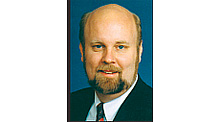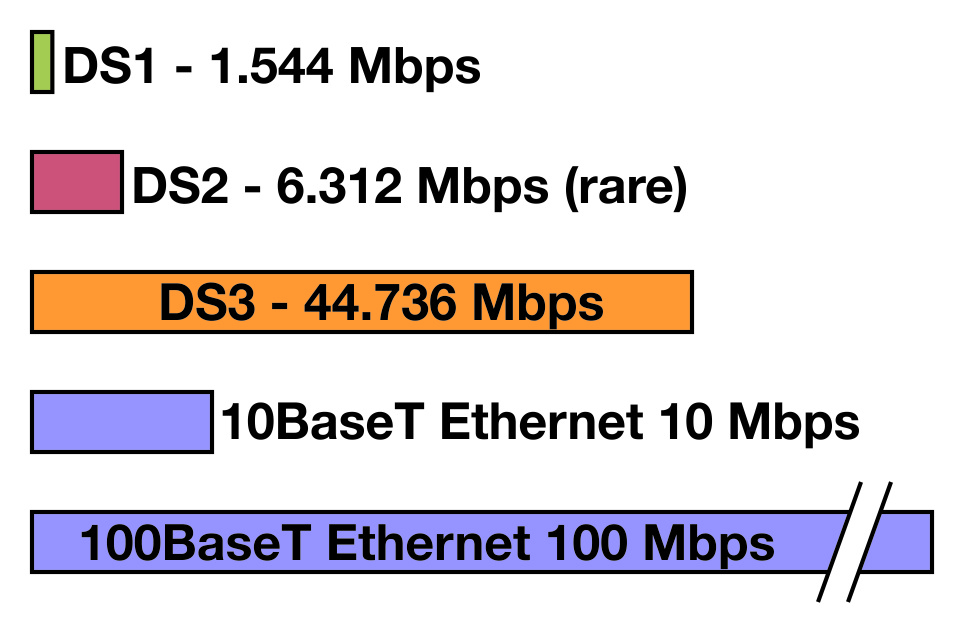The Enduring Legacy of DS3

Wes Simpson
For many broadcasters, the Digital Signal Level 3 (DS3) circuits available from U.S. telephone companies and many other carriers have long been a great option for transporting high-speed data and digital video around a metropolitan area.
Today, while Ethernet and IP-based services are currently being pushed by many carriers and some users, DS3 links can still fill a valuable role in broadcaster networks.
EVOLUTION OF A STANDARD
The DS3 standard was first created by AT&T in the 1960s, making it one of the first high-speed digital communication signal formats. Also called T3, this 44.736 Mbps signal was developed to transport 28 T1 (DS1) signals, each of which could handle 24 voice signals at 64 kbps. All told, a DS3 could be used to transport 672 telephone calls, or an equivalent amount of data. Fig. 1 gives a comparison of the bit rates for DS1, DS2 (an intermediate multiplexing step between DS1 and DS3), DS3 and two popular Ethernet line rates.
One of the unique aspects of DS3 is the method used for network clocking, called “plesiochronous.” In this system, each leg of a circuit is synchronized using an internal clock source. Minor variations in timing can be accommodated (+/-20 ppm) through the use of “stuffing bits,” which can be added or removed from the bit stream without affecting the data content or the framing pattern.
This clocking system worked well in an era where clock circuits needed some tolerance, and global clocking systems made possible by GPS were non-existent. One of the side effects of plesiochronous timing is that two DS3 signals can have exactly the same payload yet operate at slightly different bit rates, making clock recovery essential for any DS3 receiver.
APPLICATIONS
DS3 links were first deployed for long-distance telephone circuits, including a great many microwave hops between cities across the United States. In the 1970s and ’80s it was easy to find the toll-call switching center in most cities, simply by looking for a collection of microwave antennas on top of a tall downtown building. In the late ’80s and early ’90s, carriers migrated away from DS3 and toward OC-48 (2.4 Gbps) and OC-192 (9.6 Gbps) circuits for long-haul circuits.
Today, DS3 connections are used for a variety of private line services, such as studio to transmitter links and fast data circuits. With enough capacity to carry two 19.39 Mbps ATSC signals, or one ATSC plus a couple of Ethernet payloads, a DS3 has ample bandwidth for many broadcasters.
One widely installed video encryption system (that has recently been discontinued) uses DS3 interfaces between encoders and remote satellite modulators.
COMPARING DS3 AND ETHERNET SERVICES
There are many different criteria that could be used for comparing two digital services as different as DS3 and Ethernet, so we will focus on the ones that are most important to broadcasters: technology, speed of ordering and installation, reliability and price.
Technology—DS3 is a highly standardized service that operates at a single bit rate. About the only option available is the type of framing, with a choice of M13, C-bit or unframed. (Large payload signals typically use C-bit parity to benefit from less multiplexing overhead with better end-to-end error monitoring and reporting.) Terminal equipment on either end of the circuit must be specifically equipped for DS3 service by means of an interface card or a DS3 multiplexer.
Ethernet services come in a variety of speeds, technologies and quality levels. They can be delivered over dedicated/private or shared/public networks; can be Layer 2 or 3; can be deployed using MPLS or VLAN technologies; and can have a variety of bit-rate and packet-error performance guarantees. Typically, no special interfaces are required for Ethernet switches and IP routers.
Ordering and Installation—DS3 circuits, even ones that traverse multiple carrier networks, rarely have configuration issues, because there is so little variation in service offerings. In many cases, if new construction is not required, local DS3 circuits can be installed in less than a month.
Fig. 1: A comparison of the bit rates Ethernet services are often custom-configured for each user, so they can take longer to order, design and install properly, particularly if multiple carriers are involved.
Reliability—Because DS3 technology has been around for so long, carriers have highly-automated systems for monitoring and repairing problems. For Ethernet, the monitoring systems are less mature, and the circuits have more parameters that have to be correctly configured. As a result, troubleshooting can be more complex, and service restoration times can be lengthy.
Pricing—Under tariffs, telcos offer the DS3 at a fixed monthly price based on the mileage traversed by the circuit, plus a fixed price per month for each circuit termination. These prices go down for longer contract periods, which can often extend up to five years.
In contrast, many Ethernet services fall into the unregulated category, and are available from a wider range of carriers. This has benefits and drawbacks—sometimes prices are lower due to competition, but performance is also more likely to vary. Ethernet services can also be harder to obtain outside of metropolitan areas.

PLANNING FOR THE FUTURE
Broadcasters looking for 20–50 Mbps circuits should check to see if DS3 service is available to meet their needs. The results can vary greatly by geography and application. A recent pricing comparison for a 50 Mbps circuit between two pairs of cities showed DS3 to be a clear winner in one case and Ethernet in the other.
In another situation, one user achieved significant savings by installing a device to convert their existing DS3 video streams into Ethernet, which could then be transported with other services over a 10 Gbps Ethernet backbone. Fortunately, adapters are available on the market today to convert ASI and Ethernet signals into DS3, as well as to convert DS3 signals into Ethernet.
Broadcasters should keep their options open, and consider taking advantage of the enduring legacy of DS3.
Wes Simpson helped design and market DS3 test equipment in the 1980s (yes, he is that old). Thanks to Paul Atwell for his research on current DS3 pricing.
Get the TV Tech Newsletter
The professional video industry's #1 source for news, trends and product and tech information. Sign up below.
